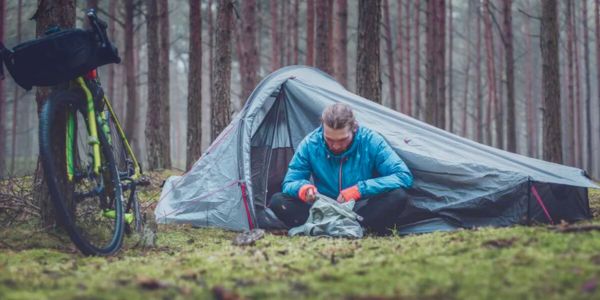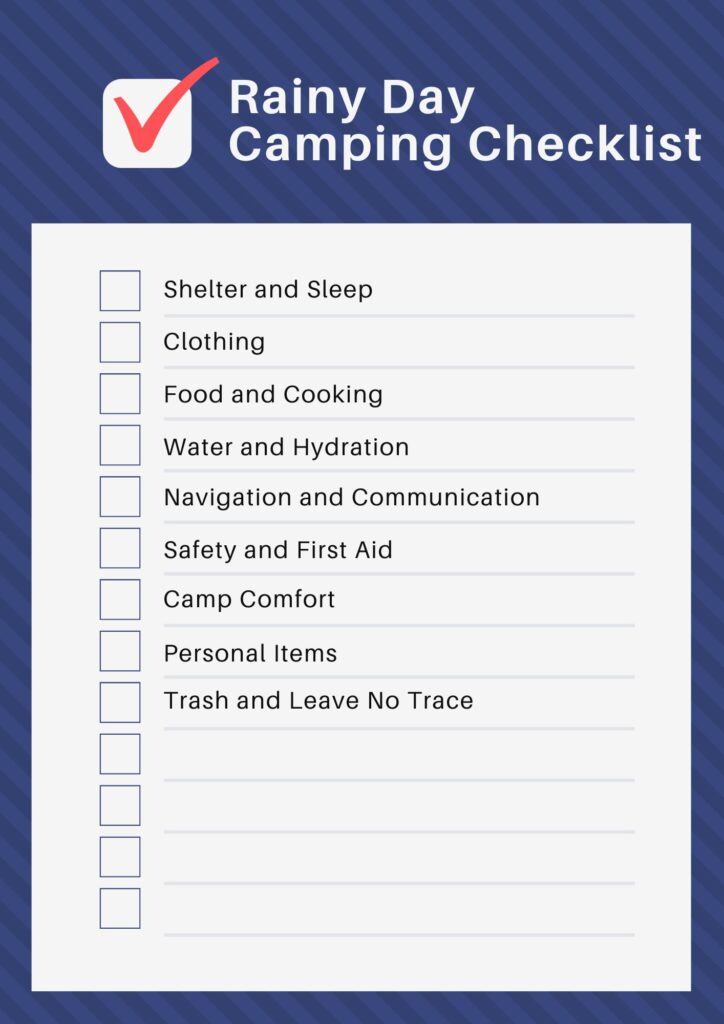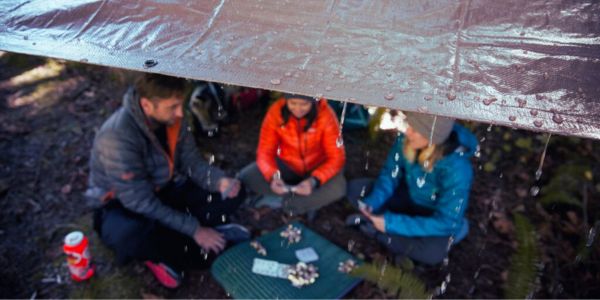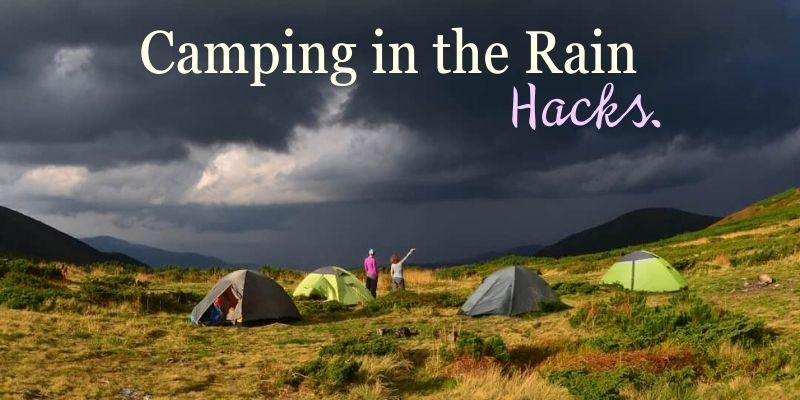When it comes to camping, a sudden downpour can turn your outdoor adventure into a soggy ordeal. But don’t let the rain dampen your spirits! With the right knowledge and preparation, you can make the most out of camping in the rain. In this article, we’ll explore some essential Camping in the Rain Hacks to help you stay dry and enjoy your rainy camping experience.
These camping in the rain hacks will not only keep you comfortable but also help you rank as a true camping pro!
Tips For Rain Camping

Here are some of the best Rain Camping Hacks
Choose a Quality Waterproof Tent
- The foundation of a successful rainy camping trip is a waterproof tent. Make sure your tent is made of high-quality, waterproof materials. Look for models with a rainfly that provides extra protection against wet weather. It’s essential to set up your tent properly to prevent leaks, so practice pitching it in advance.
Use a Ground Tarp or Footprint
- Lay a ground tarp or footprint under your tent to create an additional barrier between you and the wet ground. This extra layer will help prevent water from seeping through the tent floor and keep your sleeping area dry.
Seal Your Tent Seams
- Even the best tents can develop leaks over time. To keep your shelter waterproof, use seam sealer on the tent’s seams and any potential problem areas. This simple step can make a significant difference in keeping the interior dry.
Invest in Quality Rain Gear
- To stay comfortable while camping in the rain, invest in high-quality rain gear. A waterproof jacket, pants, and waterproof boots are essential items. Look for waterproof and breathable gear to ensure you stay dry without overheating.
Read More – Choosing a Waterproof Raincoat for Men
Pack Rain Covers for Your Backpack
- Don’t forget to protect your backpack and gear. Pack rain covers for your backpack, camera, and any other electronics or equipment you’re bringing along. Keeping your belongings dry is crucial for a successful camping trip.
Create a Rain-Free Dining Area
- Set up a rain-free dining area outside your tent by using a tarp or rainfly. This will allow you to prepare and enjoy meals without getting wet. Make sure to secure the tarp properly to prevent water from pooling and collapsing the shelter.
Light It Up with Waterproof Lighting
- Invest in waterproof lighting options like LED lanterns or headlamps to keep your campsite well-lit even in the rain. This not only helps with visibility but also enhances the ambiance of your camping experience.
Bring Entertainment for Rainy Days
- Rainy days can sometimes lead to extended periods of downtime. Be prepared with games, books, or other entertainment options to keep everyone entertained during the downpour.
Choose the Right Campsite Location
- Before setting up your tent, choose a campsite location that’s less prone to flooding and away from potential runoff areas. This simple decision can save you from waking up in a puddle.
Stay Positive and Flexible
- Remember that camping in the rain can be an adventure in itself. Stay positive, adapt to the weather conditions, and embrace the unique experience of nature’s elements.
Camping in the rain doesn’t have to be a washout. By following these camping in the rain hacks, you’ll be better prepared to face the elements and create lasting memories on your wet weather camping trip. With these tips in mind, you can make the most of your outdoor adventure, rain or shine.
How to survive camping in the rain

Plan and Prepare:
- Check the weather forecast before you go camping and be prepared for rain
- Make sure your gear is in good condition and waterproof. This includes your tent, rainfly, clothing, and camping equipment.
Choose the Right Campsite:
- Select a high and well-drained campsite to avoid water pooling around your tent.
- Avoid setting up camp in low-lying areas, and ensure there’s good water runoff around your tent.
Waterproof Gear:
- Invest in quality rain gear, including a waterproof jacket, rain pants, and waterproof boots.
- Use dry bags or waterproof stuff sacks to protect your gear and clothing.
- Make sure your tent and rainfly are set up correctly and properly sealed to prevent leaks.
Stay Dry:
- While camping, keep your rain gear on to stay dry. Change into dry clothing inside your tent.
- Use a tarp or rainfly to create a dry area for cooking, eating, and relaxing.
Hydration and Food:
- Make sure you have an adequate supply of clean water, as collecting rainwater for drinking may not always be safe.
- Plan meals that are easy to prepare in wet conditions, such as freeze-dried foods or meals that require minimal cooking.
Entertainment and Comfort:
- Bring books, cards, and other activities to keep yourself entertained during rainy spells.
- Pack a comfortable camp chair or mat to sit on when you’re inside your tent.
Stay Warm:
- Wet conditions can lead to hypothermia, so it’s crucial to stay warm. Wear moisture-wicking and insulating clothing, even when wet, to retain body heat.
- Keep a good sleeping bag and pad to insulate yourself from the cold, damp ground.
Ventilate Your Tent:
- Proper ventilation will help reduce condensation inside your tent, which can make your gear and sleeping bag damp.
Rainy Day Camping Checklist

Camping in rainy weather requires a specific checklist to ensure you have the right gear camping in the Rain Hacks
Here’s a rainy-day camping checklist to help you prepare:
Shelter and Sleep:
- Waterproof tent with a rainfly
- Ground tarp or footprint to protect the tent floor
- Extra tent stakes and guylines
- Sleeping bag rated for the expected temperature
- Sleeping pad or air mattress to insulate from the wet ground
- Pillow or stuff sack filled with clothes for a comfortable headrest
- Extra blankets or sleeping bag liners for added warmth
Clothing:
- Waterproof rain jacket with a hood
- Waterproof rain pants
- Waterproof boots or hiking shoes
- Quick-drying moisture-wicking base layers
- Warm insulating layers (fleece, down, or synthetic)
- Extra pairs of socks and underwear
- Waterproof hat or beanie
- Waterproof gloves or mittens
Food and Cooking:
- Camp stove with fuel (ensure it’s suitable for wet conditions)
- Waterproof matches or a lighter in a waterproof case
- Cooking utensils and cookware
- Biodegradable soap and sponge for washing dishes
- Quick and easy meal options like freeze-dried or dehydrated foods
- Non-perishable snacks
- Food storage containers to keep food dry
- portable solar panel
Water and Hydration:
- Clean water containers
- Water purification system or water filter
- Reusable water bottles or hydration reservoirs
- A method to collect rainwater if needed (tarp, bucket, or pots)
Navigation and Communication:
- Waterproof maps or map case
- Compass or GPS device
- Fully charged cell phone or satellite communicator in a waterproof case
- Portable power bank for recharging devices
Safety and First Aid:
- First aid kit with waterproof packaging
- Multi-tool or camping knife
- Headlamp or flashlight with extra batteries
- Whistle
- Emergency shelter (e.g., space blanket or bivy)
- Fire-starting materials (waterproof matches, firestarter, or waterproof lighter)
- Insect repellent (if applicable)
- Sunscreen and lip balm with SPF
- Personal identification and medical information
Camp Comfort:
- Dry bags or stuff sacks to keep gear dry
- Backpack rain cover or waterproof backpack liner
- Camp chairs or portable seating options
- Tarp or rainfly to create a dry outdoor space
- Towels and microfiber cloths for drying off
- Playing cards, books, or other entertainment
Personal Items:
- Toiletries (toothbrush, toothpaste, soap, etc.)
- Prescription medications
- Toilet paper and sanitation supplies
- Camping permits and identification
- Cash and small denominations of change
Trash and Leave No Trace:
- Trash bags for packing out all waste, including trash and used toilet paper
- A small portable trowel for digging a cat hole for human waste
- Biodegradable soap for washing dishes
How to keep tent Dry while rain camping

Keeping your tent dry during rainy camping is essential for a comfortable and safe Camping in the Rain Hacks.
Here are some tips to help you keep your tent dry:
Proper Tent Setup:
- Ensure your tent is correctly pitched and taut. Loose tent fabric can sag and allow water to collect, increasing the risk of leaks.
- Use all the tent’s guy lines and stakes to secure it against wind and rain.
Rainfly and Tarp Usage:
- Always use a rainfly if your tent has one. Make sure it covers the entire tent, extending over the walls.
- Set up a tarp or additional rainfly over your tent to create an extra layer of protection and provide a dry area outside the tent entrance.
Seam Sealing and Maintenance:
- Check your tent’s seams, zippers, and any areas where the rainfly attaches to the tent for wear and damage.
- Seam-seal your tent if it’s not already done. Seam sealer is available at outdoor gear stores and helps prevent water from seeping through the seams.
Use Ground Tarps:
- Lay a ground tarp or footprint under your tent to provide an extra layer of protection against moisture rising from the ground.
Ventilation:
- Keep your tent well-ventilated, even in rainy weather. Proper ventilation helps reduce condensation inside the tent.
Avoid Touching the Tent Walls:
- Try not to touch the tent walls, as this can cause water to seep through the fabric.
Dry Off Before Entry:
- Wipe your feet and body dry before entering the tent to prevent tracking water inside.
What to do while camping in the rain

Camping in the rain can be an adventure in itself, but it requires some adjustments to make the most of your experience.
Here are some activities and things to do while camping in the rain:
Stay Dry and Cozy:
- Ensure you have proper rain gear on, including a waterproof jacket, rain pants, and waterproof boots.
- Create a cozy and dry space inside your tent where you can read, play games, or simply relax.
Read a Book:
- Bring a good book or e-reader to pass the time while listening to the soothing sound of rain on your tent.
Puzzles and Board Games:
- Pack small board games or puzzles that can be played inside the tent. This is a great way to bond with your camping companions.
Listen to Nature:
- The rain can enhance the sounds of nature. Listen to the raindrops, birds, and other wildlife. It’s a serene experience.
Photography:
- Rainy weather can create unique photography opportunities.
- Use a waterproof camera or smartphone case to capture the beauty of the wet landscape.
Rainproof Cooking:
- Cook comfort food inside your tent or under a tarp.
- Soups, stews, and warm meals are perfect for rainy days.
Wildlife Observation:
- Rain often brings out more wildlife activity. Keep binoculars handy to watch birds and animals.
Crafts and DIY Projects:
- Bring simple craft supplies or start a DIY project that you’ve been putting off. Crafting can be a creative way to spend time indoors.
Practice Campfire Cooking:
- If you have a safe and covered area to cook, practice campfire cooking skills and try out new recipes.
Conclusion
Camping in the rain is an adventure like no other. It’s a chance to test your skills, connect with nature, and make lifelong memories. Armed with these camping in the rain hacks, you’re ready to face the elements with confidence.
So, get out there, don your rain gear, and immerse yourself in the beauty of nature, rain or shine. Your next camping in the rain experience is sure to be one for the books!
FAQs
Some of the FAQs for Camping in the Rain Hacks
Q: Why would anyone want to camp in the rain?
A: Camping in the rain can be a unique and thrilling experience. It’s an opportunity to connect with nature in a different way and create memorable moments. Plus, you might just have the campsite all to yourself!
Q: Is it safe to camp in the rain?
A: Absolutely, as long as you’re well-prepared. With the right gear and knowledge, you can camp safely in the rain. We’re here to share some essential hacks to make your experience enjoyable.
Q: What’s the most crucial item for camping in the rain?
A: Your waterproof tent is your best friend. It provides a cozy, dry haven in wet conditions.
Q: How can I keep my belongings dry?
A: Pack everything in waterproof bags and use rain covers for your backpack. That way, you won’t have to worry about soggy gear.
Q: What if it’s raining when I arrive at the campsite?
A: If you arrive in the rain, don’t rush to set up. Wait for a break in the weather before pitching your tent. It’ll save you a lot of hassle.

